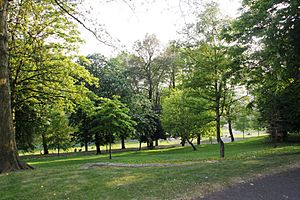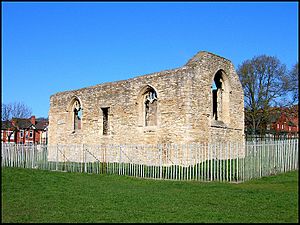St Mary Magdalene Priory, Lincoln facts for kids

The St Mary Magdalene Priory was a special kind of monastery in Lincoln, England. It was run by Benedictine monks, who followed the rules of St. Benedict. This priory was like a small branch, or "cell," of a much larger monastery called St Mary's Abbey in York, England. Another building that used to belong to this priory is called Monks' Abbey in Lincoln.
Contents
The Priory's Early Days
For a long time, people thought this priory might have been connected to a very old monastery from the 600s. This older monastery was mentioned by a famous historian named Bede. However, experts now believe that old monastery was actually in a different place called Iken in Suffolk.
There was also a story about another old religious house in Lincoln. It was said to be a monastery for nuns that existed before Remigius de Fécamp, a Benedictine Bishop, started building Lincoln Cathedral around the 1070s. Some old writings suggest there were still signs of this nunnery near where the Dean of Lincoln's house is today.
The priory received land gifts from a person named Romfar around 1115–1118. These lands were in places like Winterton, Usselby, and Osgoodby in Lincolnshire. The priory also got a lot of land in Lincoln itself, including the area where Monks Abbey is. King Henry I officially approved these gifts in 1120–1122.
Even though the original document for the priory's founding is lost, a later paper from the 1400s explains how Romfar gave the land. It said that an existing church dedicated to St Mary, along with nearby lands in an area called 'les blackmunkes', would go to the priory. The condition was that at least two monks had to live there. They would serve as chaplains in the church and hold religious services for the souls of King Richard I, Romfar, and his family. If the priory failed to do this for a year (unless there was a plague), they would lose the land. The abbot from York successfully argued that the priory had met these conditions. He used King Henry I's approval to keep the land.
Other important people, like Roger Mowbray and William, Earl of Warren, also gave gifts to the priory. King Henry II later confirmed these gifts.
The priory's main job was to look after the lands in Lincolnshire that belonged to its main monastery in York. Because of this, it was only meant to have a prior (the head monk) and one or two other monks. Even though it was small, digging at the Monks Abbey site shows that the monks had a good-sized chapel where they worshipped.
St Peter's Church and the Spring
A man named Picot gave the priory "4 acres of land and the church of St Peter, Lincoln." This Picot might have been the son of Colsuain Lincolniesis, who died during the time of King Henry I. This St Peter's church was likely on a hillside, closer to the city center than Monks Abbey. A possible location is near Spa Close in Lincoln. There was a spring in this area, known as "Black Monk's fields." In 1833, a granite well-head was added to it. Later maps from the late 1800s even marked it as "The Spa." Stone steps leading to the well were still visible in 1901.
By 1428, the area around St Peter's church had very few people living there. The church's parish (its local area) almost disappeared. But, unlike other nearby churches that closed down, St Peter's was taken over by the St Mary Magdalene Priory in 1461. The monks made sure that church services continued there. People wonder why the monks kept this church going. It's thought that they believed looking after the spring, which the church was named after, was very important. The church's full name, "St Peter ad fontem" (meaning "St Peter at the spring"), suggests the spring was already a special place before the church was built.
Monks Abbey Site
The Monks Abbey site might have been part of a large Roman villa from the 300s. This villa was found again in the late 1800s when people were digging for ironstone.
Monks Abbey is located near the River Witham. Old records show that the abbey, also called Monks Leys, owned a nearby raised path or road called 'le stampcause'. It seems many old churches or religious places were built near these river paths. This might have been part of a plan to turn important pagan (non-Christian) sites into Christian ones. Archeological finds near the Lincoln Stamp End causeway show it was an important ritual site from the Bronze Age all the way through the Middle Ages. People probably focused on water features, like the River Witham itself, for their pagan beliefs. A famous discovery from this area is the 4th-century Iron Age Witham Shield. It was found in 1826 during construction work.
Later History of the Priory
In 1531, King Henry VIII wrote to the abbot of St Mary's Abbey, York. He complained that the Lincoln priory was causing "liberty and conversation not decent and meet for religious persons." This means the king thought the monks were not behaving properly. This led to letters between the King, his advisor Thomas Cromwell, and the York abbot. These letters show that monks were slowly removed from Lincoln, even though some Benedictine monks resisted.
Old records also talk about a "Monks' Liberty" in Lincoln. This was the land and special rights of the St Mary's York cell, also known as Monk's Abbey. The abbey also owned "Monks' Leys Common," which is now the Lincoln Arboretum. In 1455, the abbot in York made an agreement about this common land with the Lincoln city government. Then, in 1585, after the king closed down many monasteries, the land officially became owned by the city. This decision came after a ruling by John Manners, 4th Earl of Rutland, who had to decide if the land should go to the city or to the "Black Monks" (another name for Benedictines).
Images for kids
-
Former Monks' Leys Common, owned by the priory, now part of the Lincoln Arboretum




